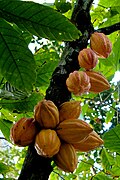Theobroma cacao
Theobroma cacao, also known as the cacao tree and the cocoa tree, is a small evergreen tree in the family Malvaceae, native to the deep tropical regions of the Americas. Its seeds, cocoa beans, are used to make cocoa mass, cocoa powder, confectionery, ganache and chocolate.
Description[edit]
Theobroma cacao is a small, 4–8 m (13–26 ft) tall evergreen tree that grows in the understory of tropical forests. Its leaves are alternate, entire, unlobed, 10–40 cm (4–16 in) long and 5–20 cm (2–8 in) broad. The flowers are produced in clusters directly on the trunk and older branches; this is known as cauliflory. The fruit, called a cacao pod, is ovoid, 15–30 cm (6–12 in) long and 8–10 cm (3–4 in) wide, ripening yellow to orange, and weighs about 500 g (1.1 lb) when ripe.
Cultivation and Harvest[edit]
Theobroma cacao is cultivated on many tropical plantations, often in the shade of other trees. It requires a humid climate with regular rainfall and good soil. The tree is harvested for its seeds, which are fermented, dried, and roasted to produce cocoa beans. The beans are then ground into a paste known as chocolate liquor, from which cocoa solids and cocoa butter are extracted.
Uses[edit]
The primary use of Theobroma cacao is in the production of chocolate. The cocoa beans are roasted and ground to produce a liquid or paste known as chocolate liquor, which can be separated into cocoa solids and cocoa butter. The cocoa solids can be used to make chocolate, while the cocoa butter is often used in cosmetics and pharmaceuticals.
Health Benefits[edit]
Cocoa has been known to have several health benefits. It is rich in flavonoids, which are known to have antioxidant properties. Cocoa also contains a significant amount of dietary fiber and is a good source of minerals such as magnesium and iron.
See Also[edit]
-
Theobroma cacao
-
Theobroma cacao
-
Theobroma cacao
-
Theobroma cacao
-
Theobroma cacao
-
Theobroma cacao
-
Theobroma cacao
-
Theobroma cacao
-
Theobroma cacao
-
Theobroma cacao
-
Theobroma cacao
-
Theobroma cacao
Ad. Transform your life with W8MD's Budget GLP-1 injections from $75


W8MD offers a medical weight loss program to lose weight in Philadelphia. Our physician-supervised medical weight loss provides:
- Weight loss injections in NYC (generic and brand names):
- Zepbound / Mounjaro, Wegovy / Ozempic, Saxenda
- Most insurances accepted or discounted self-pay rates. We will obtain insurance prior authorizations if needed.
- Generic GLP1 weight loss injections from $75 for the starting dose.
- Also offer prescription weight loss medications including Phentermine, Qsymia, Diethylpropion, Contrave etc.
NYC weight loss doctor appointmentsNYC weight loss doctor appointments
Start your NYC weight loss journey today at our NYC medical weight loss and Philadelphia medical weight loss clinics.
- Call 718-946-5500 to lose weight in NYC or for medical weight loss in Philadelphia 215-676-2334.
- Tags:NYC medical weight loss, Philadelphia lose weight Zepbound NYC, Budget GLP1 weight loss injections, Wegovy Philadelphia, Wegovy NYC, Philadelphia medical weight loss, Brookly weight loss and Wegovy NYC
|
WikiMD's Wellness Encyclopedia |
| Let Food Be Thy Medicine Medicine Thy Food - Hippocrates |
Medical Disclaimer: WikiMD is not a substitute for professional medical advice. The information on WikiMD is provided as an information resource only, may be incorrect, outdated or misleading, and is not to be used or relied on for any diagnostic or treatment purposes. Please consult your health care provider before making any healthcare decisions or for guidance about a specific medical condition. WikiMD expressly disclaims responsibility, and shall have no liability, for any damages, loss, injury, or liability whatsoever suffered as a result of your reliance on the information contained in this site. By visiting this site you agree to the foregoing terms and conditions, which may from time to time be changed or supplemented by WikiMD. If you do not agree to the foregoing terms and conditions, you should not enter or use this site. See full disclaimer.
Credits:Most images are courtesy of Wikimedia commons, and templates, categories Wikipedia, licensed under CC BY SA or similar.
Translate this page: - East Asian
中文,
日本,
한국어,
South Asian
हिन्दी,
தமிழ்,
తెలుగు,
Urdu,
ಕನ್ನಡ,
Southeast Asian
Indonesian,
Vietnamese,
Thai,
မြန်မာဘာသာ,
বাংলা
European
español,
Deutsch,
français,
Greek,
português do Brasil,
polski,
română,
русский,
Nederlands,
norsk,
svenska,
suomi,
Italian
Middle Eastern & African
عربى,
Turkish,
Persian,
Hebrew,
Afrikaans,
isiZulu,
Kiswahili,
Other
Bulgarian,
Hungarian,
Czech,
Swedish,
മലയാളം,
मराठी,
ਪੰਜਾਬੀ,
ગુજરાતી,
Portuguese,
Ukrainian













